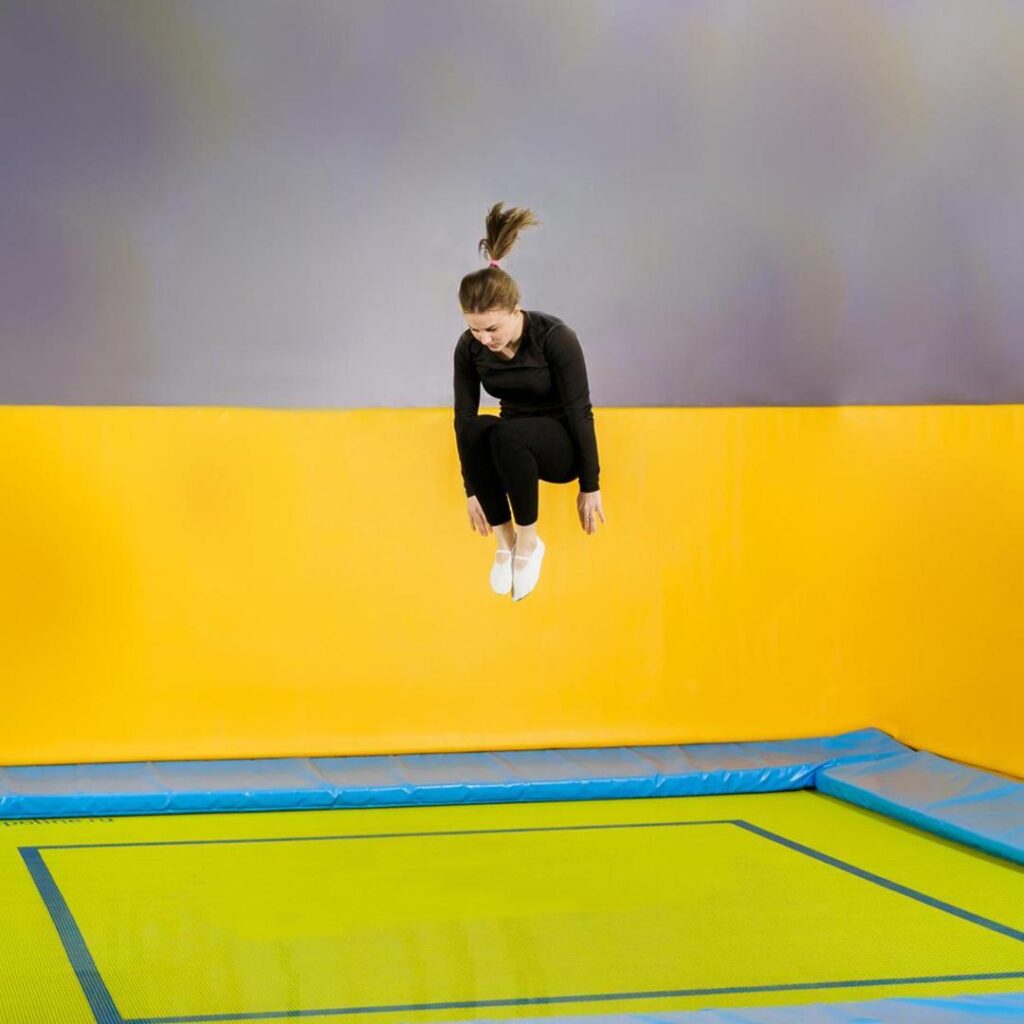
As we gracefully age, the importance of regular exercise in maintaining our health and vitality cannot be overstated. For seniors, staying active is key to enhancing quality of life, managing health conditions, and boosting mental health. However, finding the right type of exercise that is both enjoyable and gentle on the body can be a challenge. This is where trampoline exercises, or rebounding, come into play.
Trampoline offer a unique combination of fun and fitness, providing a low-impact workout that spares the joints while still offering a comprehensive cardiovascular workout. Unlike running or other high-impact activities that can be tough on the body, rebounding allows seniors to engage in vigorous exercise with a significantly reduced risk of injury. The gentle bouncing motion is effective in strengthening muscles, improving balance and coordination, and boosting cardiovascular health.
In recent years, the popularity of trampoline exercises among seniors has seen a remarkable rise. This growing trend can be attributed to the numerous health benefits associated with rebounding, coupled with the sheer joy of feeling weightless as you bounce. It’s a form of exercise that not only keeps the body healthy but also brings a smile to your face, making it a perfect choice for seniors looking to add a dose of happiness to their fitness routine.
In this blog post, we will explore 9 trampoline exercises specifically designed for seniors to keep them healthy and happy. Whether you’re looking to start a new fitness journey or spice up your current routine, these exercises are bound to provide both the fun and health benefits you’re seeking.
Why Trampoline Exercises for Seniors?
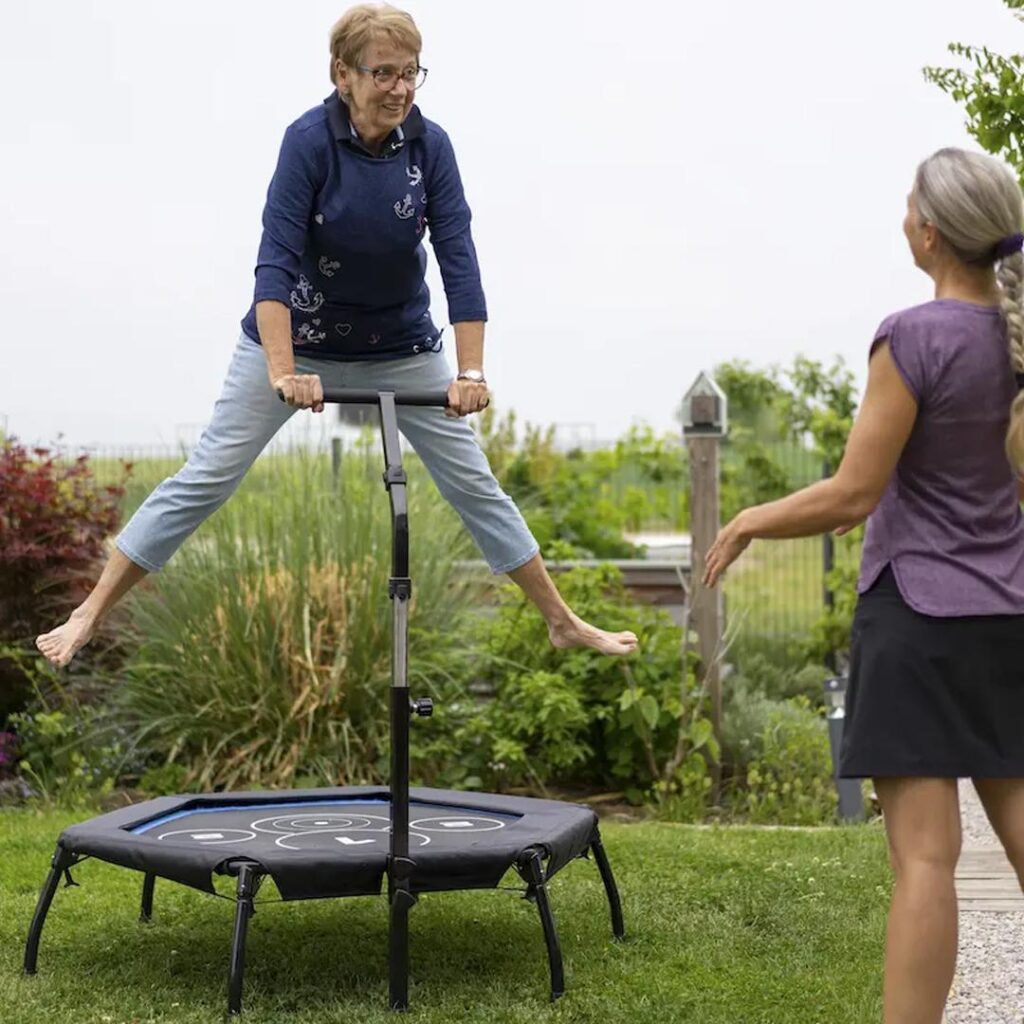
Trampoline exercises, or rebounding, offer a multitude of benefits for seniors. Let’s know why they are an ideal choice for maintaining health and happiness in later years.
Low-Impact Nature
- Joint Health: Rebounding is gentle on the joints compared to high-impact exercises, making it suitable for seniors with or looking to prevent joint issues.
- Accessibility: The low-impact nature ensures that people with varying fitness levels can participate, reducing the fear of injury.
Improvement in Balance and Coordination
- Core Strength: Bouncing on a trampoline engages the core muscles, improving balance and reducing the risk of falls.
- Motor Skills: The act of keeping oneself balanced on the trampoline enhances coordination and fine-tunes motor skills.
Enhanced Cardiovascular Health
- Heart Rate: Similar to more vigorous forms of exercise, trampoline exercises increase the heart rate, promoting cardiovascular fitness.
- Blood Circulation: Improved blood circulation from rebounding can lower blood pressure and reduce the risk of heart-related issues.
Boosted Lymphatic Flow
- Detoxification: The vertical movement in rebounding significantly enhances lymphatic flow, aiding in the removal of toxins from the body.
- Immune Function: Increased lymphatic circulation helps in bolstering the immune system, keeping seniors healthier.
Preparation and Safety Tips
Embarking on a trampoline exercise routine can be a fun and rewarding way to improve your health. However, ensuring safety and proper preparation is key, especially for seniors. For a head start, consider these essential recommendations:
Selecting the Right Trampoline
- Size Matters: Consider a trampoline that is spacious enough to allow freedom of movement but sized appropriately for your living space. Mini trampolines work well indoors.
- Stability Features: Look for trampolines with handlebars. These provide balance support, making exercises safer and more accessible.
- Quality and Durability: Opt for a trampoline with a sturdy frame and high-quality mat. It should also have a weight limit that accommodates you comfortably.
Wearing Appropriate Accessories
- Wear Comfortable and Flexible Clothing: When using a trampoline, it is essential to wear comfortable and flexible clothing that allows for a full range of motion. Loose clothing can pose safety risks as it can become entangled in the trampoline or other equipment. Instead, opt for snug-fitting attire that stays close to your body, reducing the risk of getting caught. Steer clear of clothing that could limit your movement, such as long scarves, loose pants, or flowing skirts.
- Trampoline Socks for Safety: Trampoline socks are essential for safe trampoline use. These socks provide traction and prevent slipping on the trampoline surface, reducing the risk of falls and injuries. Opting for High-quality Supertramp trampoline socks with a no-slip grip enhances stability and balance while bouncing, ensuring a safer and more enjoyable experience.
Always go for high-quality trampoline accessories to maintain safety and durability, ensuring endless bouncing joy.
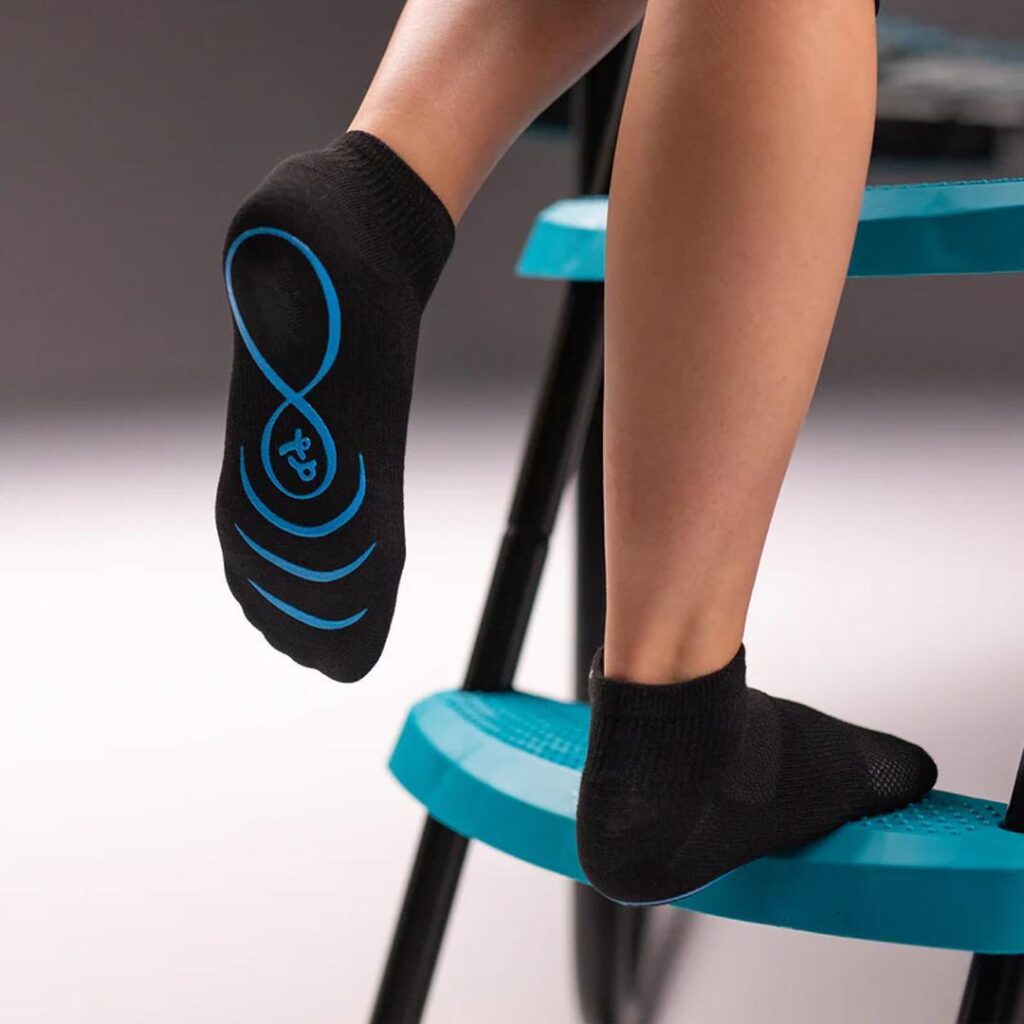
Warm-Up Exercises
- Gentle Stretching: Begin with gentle stretches to loosen up your muscles and joints. Focus on areas like your arms, legs, and back.
- Start Slow: Initiate your trampoline session with slow, low bounces. This helps your body adjust to the bouncing motion and warms up your muscles further.
Consulting with a Healthcare Provider
- Professional Advice: Before starting any new exercise regimen, especially trampoline exercises, consult with your healthcare provider. This is crucial if you have existing health conditions or concerns.
- Tailored Recommendations: A healthcare professional can offer personalized advice and modifications to ensure that your trampoline exercise routine is safe and beneficial for your specific health needs.
9 Trampoline Exercises for Seniors
Engaging in garden trampoline exercises can significantly enhance the health and happiness of seniors. These exercises are designed to be low-impact, safe, and beneficial for individuals at this stage of life. Here’s a deeper look into each of the exercises:
1. Gentle Bounce
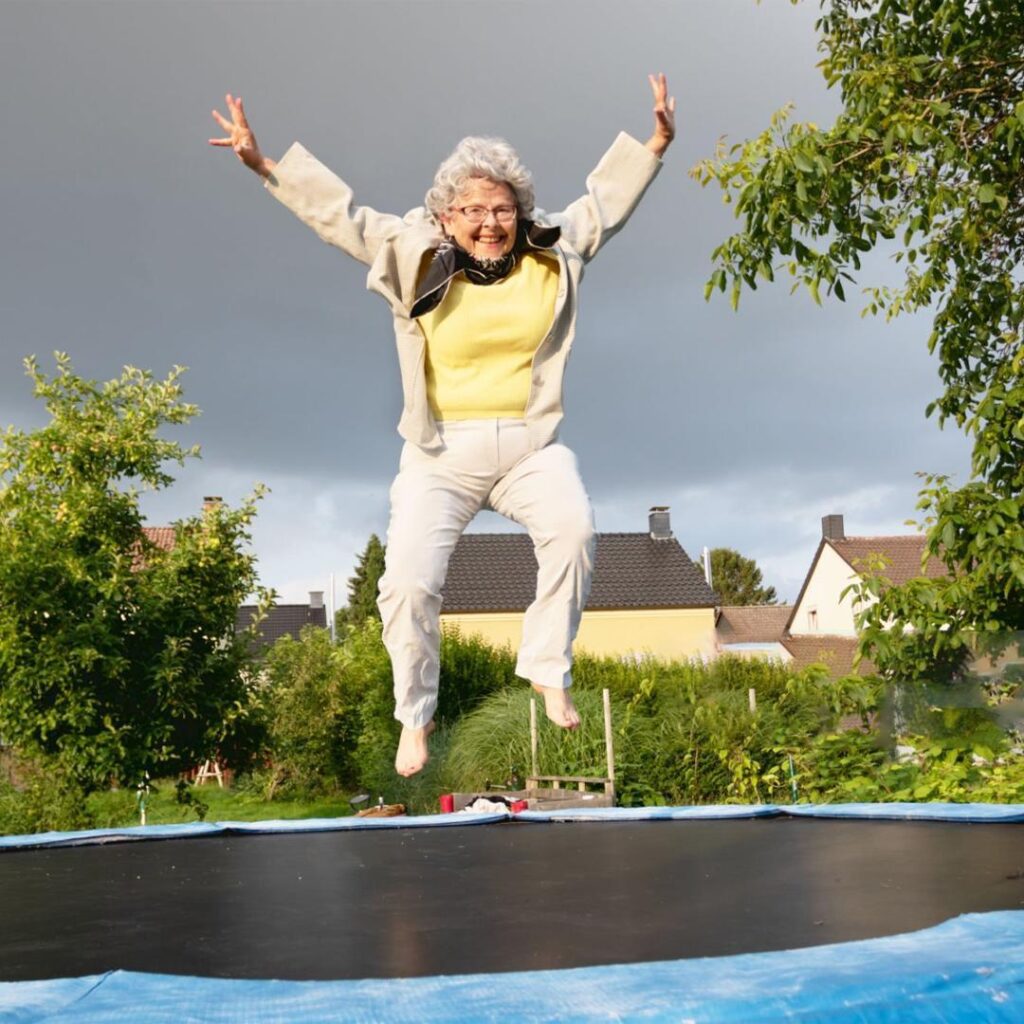
The Gentle Bounce is the perfect starting point for seniors new to trampoline workouts. This exercise involves basic, low bounces where the feet barely leave the trampoline’s surface. It’s an excellent way to warm up the body, allowing muscles and joints to ease into the workout gently. The beauty of the gentle bounce lies in its simplicity and effectiveness in preparing the body for more vigorous activity, ensuring that the exercise session progresses smoothly and safely.
2. Pelvic Floor Jump
Building on the gentle bounce, the Pelvic Floor Jump shifts the focus slightly, emphasizing the engagement of the pelvic floor muscles. By consciously tightening these muscles with each bounce, participants work to strengthen an area that is crucial for core stability and control. For seniors, especially, strengthening the pelvic floor is beneficial as it supports bladder function and contributes to overall pelvic health, enhancing quality of life.
3. Knee Lifts
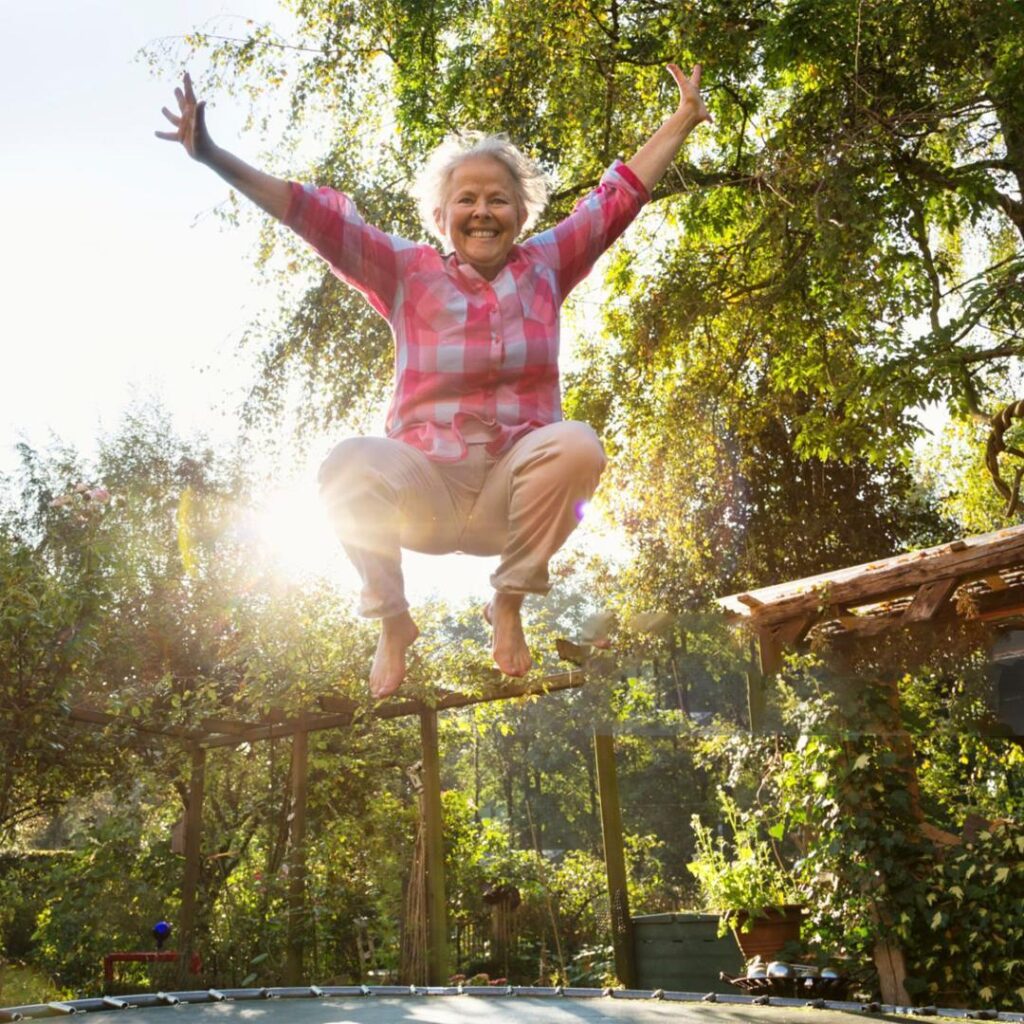
Knee Lifts take the workout up a notch, incorporating alternating knee lifts to a comfortable height with each bounce. This exercise challenges balance and coordination while strengthening the leg muscles. The action of lifting the knees engages the lower body in a way that promotes muscle strength, which is vital for maintaining mobility and preventing falls, a common concern among older adults.
4. Side-to-Side Bounces
Side-to-side bounces add a fun twist to the workout, involving gentle bounces while shifting weight from side to side. This exercise not only enhances lateral movement and balance but also engages the core muscles. The dynamic movement involved in shifting weight from one side to the other challenges the body’s stability mechanisms, thereby strengthening the core and improving overall balance.
5. Twist Jumps
With Twist Jumps, seniors can enjoy an exercise that introduces gentle twists at the waist while keeping the head facing forward. This movement increases flexibility and strength in the abdominal and back muscles, areas that are crucial for maintaining good posture and preventing back pain. Additionally, the rotational movement of the twisted jump promotes spinal health, encouraging flexibility and mobility in the spine.
6. Seated Bounces
Seated Bounces are an innovative way for seniors to enjoy the benefits of In-ground trampoline exercises without the necessity of standing. This exercise involves sitting in the center of the trampoline and using the legs and core strength to initiate a bounce. It’s a fantastic option for those who may have balance issues or prefer a less intense starting point. The core and legs are actively engaged during the process, providing a solid workout that strengthens these areas while minimizing the risk of falls. Additionally, this exercise subtly enhances balance capabilities by requiring the individual to maintain stability while in motion, a skill that is beneficial in daily activities.
7. Arm Circles

Integrating Arm Circles into trampoline exercises allows for an upper-body workout that complements the lower-body and core exercises typically associated with rebounding. While performing gentle bounces, seniors can extend their arms and perform slow, controlled circles. This movement not only improves upper body strength but also enhances coordination and balance. The act of coordinating arm movements with the bouncing rhythm can be both a mental and physical exercise, contributing to overall agility and motor skills.
8. Heel Raises
Heel Raises on a trampoline adds a unique challenge to what might seem like a simple exercise off the trampoline. By lifting the heels off the mat while keeping the toes grounded, and possibly incorporating gentle bounces, seniors can effectively target their calf muscles. This exercise is excellent for strengthening the lower leg muscles, which play a crucial role in walking and balance. Moreover, the focus on ankle movement and stability can help prevent falls by enhancing the body’s ability to recover from sudden shifts in movement or terrain.
9. Cool Down Stretch
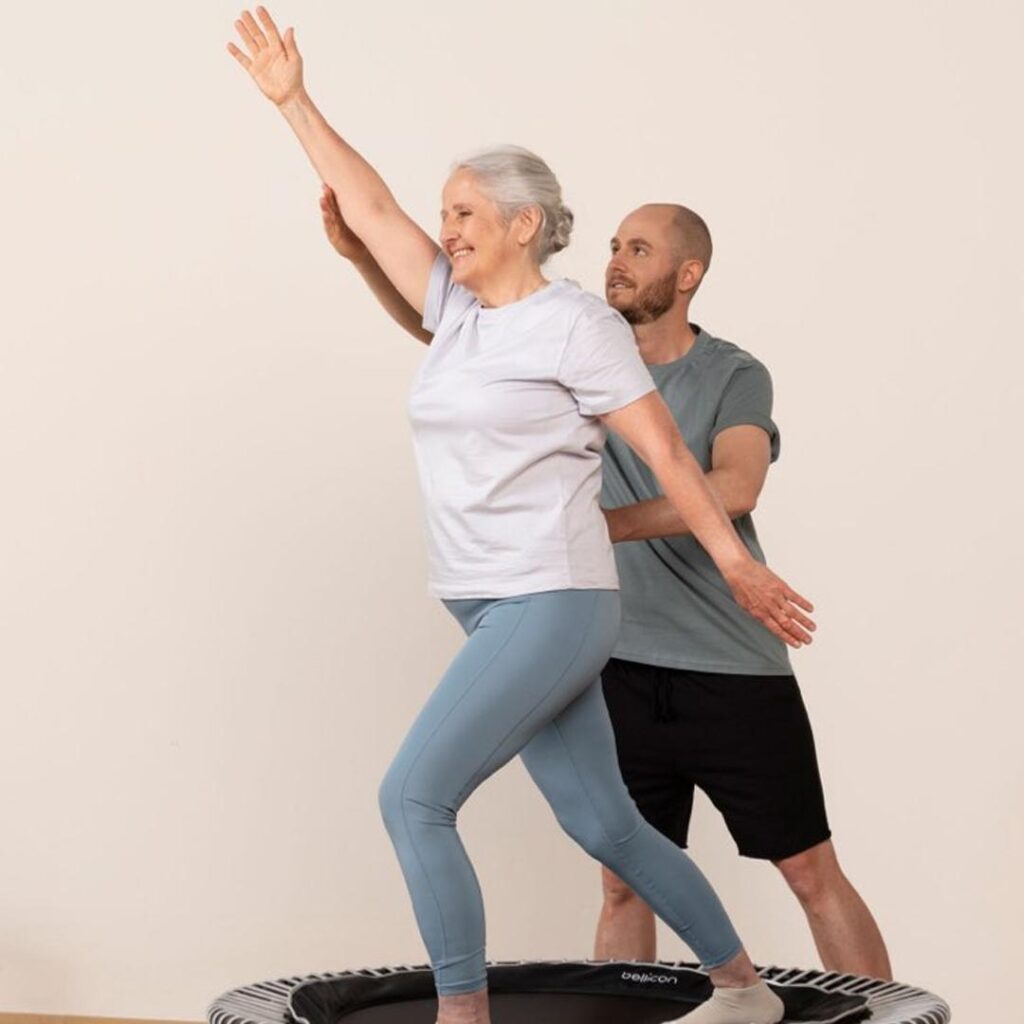
After the dynamic movements of a fitness trampoline workout, it’s essential to engage in a Cool Down Stretch. These stretching exercises, performed after stepping off the trampoline, are crucial for easing the body back into a state of rest. Gentle stretches can help reduce muscle soreness, increase flexibility, and promote relaxation. Focusing on major muscle groups that were engaged during the workout, such as the legs, back, and arms, ensures a thorough cool down. This practice not only aids in recovery but also prepares the body for the next exercise session, reducing the risk of injury and enhancing the benefits of the trampoline workout.
Incorporating Trampoline Exercises into Daily Life
Incorporating bespoke trampoline exercises into daily life can transform the routine of seniors, offering a fun and effective way to enhance physical health and overall well-being. Creating a sustainable routine and gradually increasing the intensity and duration of workouts as fitness levels improve are key strategies for success. Here are some insights and tips to help make trampoline exercises a regular part of daily life:
Creating a Sustainable Routine
- Set Realistic Goals: Begin by setting achievable goals that align with your current fitness level and health conditions. Starting with shorter sessions a few times a week can help build the habit without overwhelming you.
- Routine Integration: Integrate trampoline exercises into your daily routine at times that work best for you. Some may prefer a morning bounce to energize their day, while others might find a mid-afternoon or early evening session more beneficial.
- Variety is Key: Keep your routine interesting by varying the exercises. Incorporating different movements not only prevents boredom but also ensures a well-rounded workout that targets multiple muscle groups.
- Track Progress: Keeping a simple log of your exercises, how you felt during and after the session, and any progress toward your goals can be highly motivating. It also helps in identifying when it’s time to increase the intensity or variety of your routine.
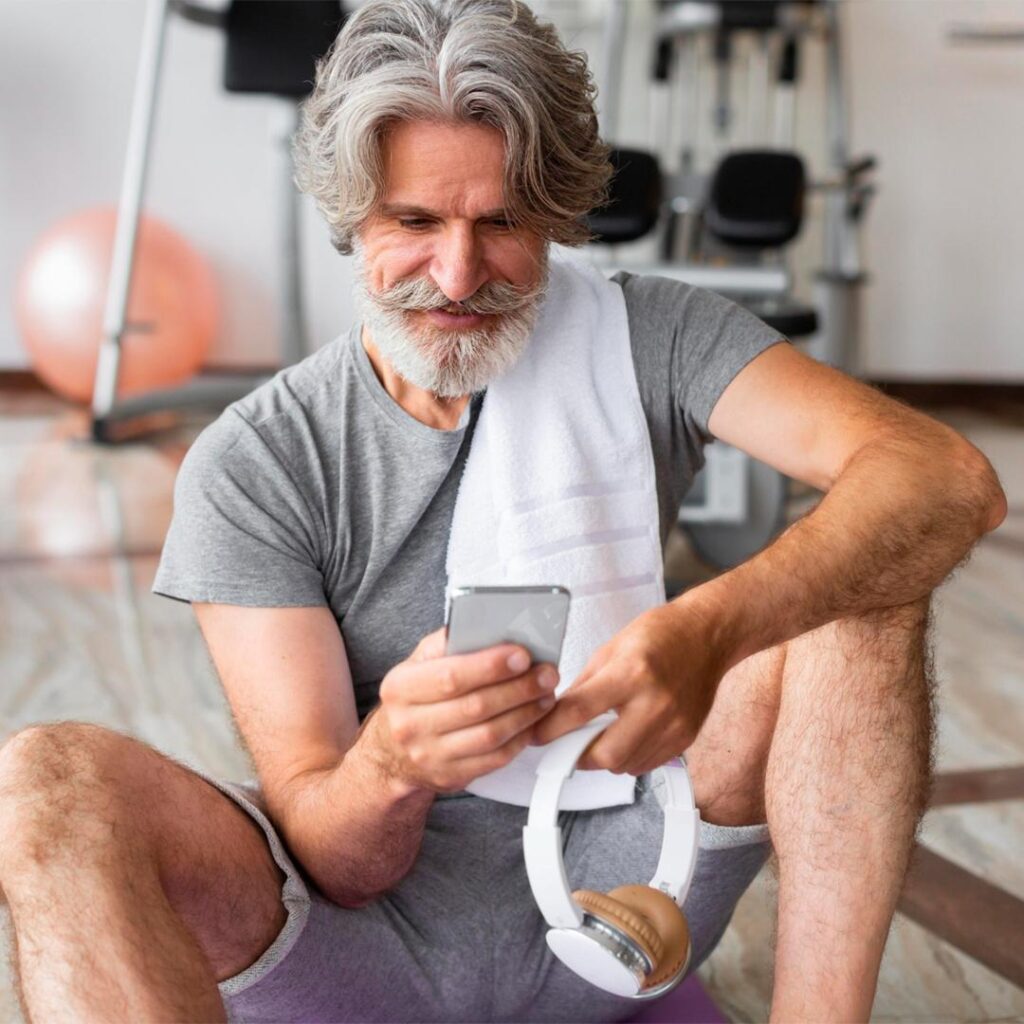
Gradually Increasing Intensity and Duration
- Listen to Your Body: Pay attention to how your body responds during and after exercises. Gradual increases in intensity and duration should be comfortable and sustainable. If you experience discomfort or fatigue, it may be wise to scale back and progress more slowly.
- Incremental Changes: Small, incremental changes can lead to significant improvements over time. For example, increasing the duration of your workout by a few minutes every week or introducing a new exercise can effectively enhance your fitness without the risk of injury.
- Challenge Yourself: As your fitness improves, challenge yourself with slightly more complex exercises or higher-intensity bounces. This not only helps in building strength and endurance but also keeps the workout engaging.
- Seek Guidance: Don’t hesitate to seek advice from fitness professionals, especially when looking to intensify your routine. They can provide valuable insights on safely adding more challenging exercises to your regimen.
Encouragement and Support
- Celebrate Milestones: Recognize and celebrate milestones, no matter how small. Whether it’s increasing your workout time or mastering a new exercise, acknowledging these achievements can provide a significant motivational boost.
- Social Support: Consider joining a group or finding a workout buddy who also enjoys trampoline exercises. Sharing the experience can make exercising more enjoyable and keep you accountable.
- Stay Positive: Embrace a positive mindset towards your fitness journey. Remember, incorporating rectangle trampoline exercises into your daily life is not just about physical health but also about enjoying a happier, more active lifestyle.
By following these tips, seniors can successfully make trampoline exercises an enjoyable and beneficial part of their daily routine, leading to improved health, greater mobility, and enhanced quality of life.
Conclusion
Trampoline exercises offer seniors a fun and low-impact way to boost their health, from enhancing cardiovascular fitness to improving balance and muscle strength. This enjoyable form of exercise not only promotes physical well-being but also contributes to a happier, more active lifestyle. Starting with simple movements and gradually increasing intensity can lead to significant health benefits. We encourage seniors to take the first step towards a healthier, more vibrant life by incorporating Supertramp trampoline workouts into their daily routine. Embrace the bounce and discover a joyful path to wellness.


